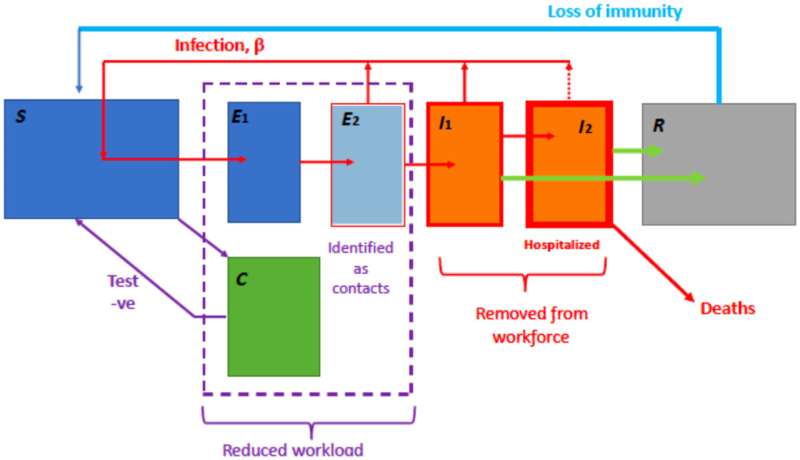This article has been reviewed according to Science X's editorial process and policies. Editors have highlighted the following attributes while ensuring the content's credibility:
fact-checked
peer-reviewed publication
trusted source
proofread
Balancing economic and epidemiological interventions in the early stages of pathogen emergence

In the first two years of the COVID-19 pandemic, policymakers around the world were faced with decisions that pitted human health against the economy. Before we had tests, vaccines, or even a solid understanding of disease transmission, countries made individual decisions about how to minimize both hospitalizations and economic damages. Some issued strict lockdowns; others imposed few or no restrictions.
But SARS-CoV-2 will not be the last novel virus to threaten humans—we've had at least 20 pathogens of concern in the past 50 years. The authors of a recent study, "Balancing economic and epidemiological interventions in the early stages of pathogen emergence," published in Science Advances, propose a new model for examining the interplay of epidemiology and economics that could give policymakers guidelines when we face novel outbreaks in the future.
"A lot of the decisions in the first months of COVID were being made for economic reasons rather than epidemiological reasons," says SFI External Professor Andrew Dobson (Princeton University), lead author of the study. "There wasn't a good framework for blending economic theories of jobs and economies together with epidemics."
In the paper, the researchers use their model to test how a variety of early-stage tools—doing nothing, lockdowns, testing, and tracing—impact public health and economic outcomes when used in various combinations, and how those outcomes change with delayed action.
The team first compared lockdowns with a laissez-faire approach. They found that, if lockdowns are initially the only tool available, they produce better health and economic outcomes than doing nothing, and that delaying action leads to deeper economic impacts and more deaths. "As long as you react quite quickly, it's always better to close things down than to do nothing," says Dobson.
However, as soon as reliable testing is widely available, the best course of action changes. Random testing produces better results than lockdowns. And even better is contact tracing, targeted testing of known contacts, and isolation of infected persons. Dobson says, "If you can identify people even with a broad brush and then test them, you are using fewer tests, and you're effectively stopping the epidemic by isolating people who've been contacts." This means fewer deaths and a reduced impact on the economy.
But even this advice is context-dependent. When tests are hard to come by or are relatively expensive, a country might be better off using the blunt tool of lockdowns.
"We felt this was a missing bit—having a proper integrated economic and epidemiological framework," says Dobson. The team plans to continue expanding this model, adding factors like age and gender, vaccination status, and the ability to consider specific sectors within the economy. They will also continue working on individual-level factors that play into the spread of disease—choices like mask-wearing even when it's not mandated or refusing to comply with behavioral guidelines.
"Behavioral choices and constraints, as well as individual susceptibility, reflecting socio-economic conditions should, of course, be considered going forward with this kind of analysis," says co-author Mercedes Pascual, an SFI External Professor based at the University of Chicago. "We view this model as a start and a benchmark for comparison, to establish how robust given conclusions are to what will always remain a simple representation of a complex system."
The study arrives at an interesting moment as the U.S. health emergency lifts and many countries are conducting internal investigations about their pandemic response. "One thing COVID has hugely underlined to me is that, in general, we need a much higher level of scientific understanding among the public, and massively so among political decision-makers," says Dobson. He hopes that this paper will serve as a frame of reference.
More information: Andy Dobson et al, Balancing economic and epidemiological interventions in the early stages of pathogen emergence, Science Advances (2023). DOI: 10.1126/sciadv.ade6169





















